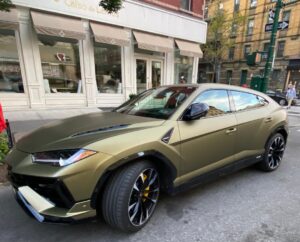
The Pinnacle of Autonomy: Exploring the Top Luxury Cars with Advanced Self-Driving Features
The automotive landscape is rapidly evolving, driven by the relentless pursuit of autonomous driving technology. While fully self-driving cars remain on the horizon, a growing number of luxury vehicles are equipped with advanced driver-assistance systems (ADAS) that offer a tantalizing glimpse into the future of transportation. These systems, often packaged as "autonomous driving features," aim to enhance safety, reduce driver fatigue, and provide a more relaxed and convenient driving experience.
This article delves into the top luxury cars currently available that boast the most sophisticated autonomous driving features. We’ll explore their capabilities, limitations, and the overall experience they offer, providing a comprehensive overview for discerning buyers considering investing in this cutting-edge technology.
Defining "Autonomous Driving Features" in the Luxury Segment
Before we dive into specific models, it’s crucial to define what we mean by "autonomous driving features" in the context of luxury cars. Currently, no commercially available vehicle is truly self-driving (Level 5 autonomy). Instead, luxury cars offer Level 2 or, in some cases, limited Level 3 autonomy. This means the systems can assist with steering, acceleration, and braking under certain conditions, but the driver must remain attentive and ready to take control at any moment.
Key features that contribute to this semi-autonomous experience include:
- Adaptive Cruise Control (ACC): Maintains a set speed and automatically adjusts to maintain a safe following distance from the vehicle ahead. Advanced ACC systems can also handle stop-and-go traffic.
- Lane Keeping Assist (LKA): Helps keep the vehicle centered in its lane by providing steering corrections.
- Lane Departure Warning (LDW): Alerts the driver if the vehicle is drifting out of its lane without signaling.
- Automatic Emergency Braking (AEB): Detects potential collisions and automatically applies the brakes to mitigate or avoid an impact.
- Traffic Jam Assist: Combines ACC and LKA to provide automated driving in low-speed traffic.
- Blind Spot Monitoring (BSM): Alerts the driver to vehicles in their blind spots.
- Rear Cross Traffic Alert: Warns the driver of approaching vehicles when backing up.
- Automatic Parking Assist: Helps the driver park the vehicle by controlling steering, acceleration, and braking.
- Navigation-Based Adaptive Cruise Control: Uses map data to anticipate curves, hills, and speed limit changes, adjusting the vehicle’s speed accordingly.
- Driver Monitoring Systems: Uses cameras or sensors to monitor the driver’s attention and alertness, providing warnings if they appear drowsy or distracted.
The Contenders: Top Luxury Cars with Advanced Autonomous Driving Features
Here are some of the leading luxury cars that stand out for their sophisticated autonomous driving capabilities:
-
Mercedes-Benz S-Class: The S-Class has long been a benchmark for automotive technology, and its autonomous driving features are no exception. The latest generation boasts a comprehensive suite of ADAS, including Drive Pilot, a Level 3 system that allows for hands-free driving under specific conditions (currently only approved in limited areas and situations). Drive Pilot can handle steering, acceleration, and braking in heavy traffic on suitable highway sections, allowing the driver to engage in secondary activities, such as checking emails or watching a movie on the central display. Beyond Drive Pilot, the S-Class offers advanced versions of ACC, LKA, and AEB, along with a sophisticated driver monitoring system. The overall system is highly refined and provides a smooth, confident driving experience.
Strengths: Drive Pilot (limited availability), comprehensive ADAS suite, smooth and refined performance, advanced driver monitoring.
Weaknesses: Drive Pilot availability is limited, high price point, system complexity can be overwhelming for some users.
-
BMW i7/7 Series: BMW’s flagship sedan offers a compelling blend of luxury and technology. The i7/7 Series features Driving Assistant Professional, which includes ACC with Stop&Go, Lane Keeping Assistant with side collision avoidance, Automatic Lane Change, and Parking Assistant Plus. The system is highly capable on highways, providing confident steering assistance and maintaining a safe following distance. The Automatic Lane Change feature is particularly noteworthy, allowing the vehicle to automatically change lanes when the driver activates the turn signal. BMW also offers a robust driver monitoring system.
Strengths: Intuitive interface, advanced lane-keeping and lane-changing capabilities, excellent driver monitoring, comprehensive ADAS suite.
Weaknesses: Can be overly sensitive in certain situations, driver monitoring system can be intrusive for some users.
-
Audi A8: Audi’s A8 is another strong contender in the luxury sedan segment. While it doesn’t currently offer a true Level 3 system like the S-Class, its Level 2 ADAS features are highly advanced. The A8 includes Adaptive Cruise Assist, which combines ACC, LKA, and traffic jam assist to provide automated driving in a wider range of conditions. It also features a sophisticated automatic parking system and a comprehensive suite of safety features.
Strengths: Well-integrated ADAS features, smooth and predictable performance, comfortable ride, user-friendly interface.
Weaknesses: Lacks a true Level 3 system, some features require optional packages, can feel less cutting-edge compared to competitors.
-
Tesla Model S/Model X: While not traditionally considered a "luxury" brand in the same vein as Mercedes-Benz or BMW, Tesla’s Model S and Model X offer impressive autonomous driving capabilities through their Autopilot and Full Self-Driving (FSD) systems. Autopilot comes standard and includes ACC and LKA. FSD, an optional package, adds features like automatic lane changes, navigate on Autopilot (which guides the car from on-ramp to off-ramp on highways), and traffic light and stop sign control. However, it is important to note that Tesla’s FSD is not fully self-driving and requires constant driver supervision. The system has been the subject of scrutiny due to its naming and reported safety concerns.
Strengths: Advanced lane-keeping and lane-changing capabilities, innovative features like Navigate on Autopilot, over-the-air software updates.
Weaknesses: FSD is not fully self-driving despite its name, system reliability and safety have been questioned, driver monitoring system can be inconsistent.
-
Genesis G90: Genesis, Hyundai’s luxury brand, offers a compelling value proposition with the G90. The G90 is equipped with Highway Driving Assist 2 (HDA2), which combines ACC, LKA, and lane change assist to provide a semi-autonomous driving experience on highways. HDA2 is surprisingly capable and provides smooth and confident steering assistance. The G90 also features a comprehensive suite of safety features.
Strengths: Excellent value for money, surprisingly capable HDA2 system, comfortable ride, comprehensive safety features.
Weaknesses: Less prestigious brand image, interior design is not as opulent as some competitors, HDA2 is not as refined as systems from Mercedes-Benz or BMW.
The Reality of Autonomous Driving: Capabilities and Limitations
It’s crucial to understand that even the most advanced "autonomous driving features" in these luxury cars are not a substitute for a human driver. These systems are designed to assist the driver, not replace them. They rely on sensors, cameras, and software that can be affected by weather conditions, road markings, and other factors.
Here are some key limitations to keep in mind:
- Reliance on Ideal Conditions: Autonomous driving systems typically perform best in clear weather, well-marked roads, and predictable traffic conditions. They may struggle in heavy rain, snow, fog, or on poorly maintained roads.
- Limited Operational Design Domain (ODD): Each system has a specific ODD, which defines the conditions under which it is designed to operate safely. Driving outside of the ODD can lead to system malfunctions or disengagements.
- Driver Responsibility: Even when using autonomous driving features, the driver remains responsible for the vehicle’s operation. They must be attentive and ready to take control at any moment.
- Ethical Dilemmas: Autonomous driving systems may face ethical dilemmas in certain situations, such as unavoidable collisions. How the system is programmed to respond in these situations is a complex and evolving issue.
- Cybersecurity Risks: Autonomous driving systems are vulnerable to cybersecurity threats, which could potentially compromise their safety and security.
The Future of Autonomous Driving in Luxury Cars
The development of autonomous driving technology is ongoing, and we can expect to see significant advancements in the coming years. Future luxury cars will likely feature more sophisticated sensors, improved software algorithms, and expanded ODDs. True Level 3 autonomy will become more widespread, allowing for hands-free driving in a wider range of conditions.
However, the road to fully autonomous driving is still long and complex. Regulatory hurdles, ethical considerations, and technological challenges remain. In the meantime, the advanced driver-assistance systems in today’s luxury cars offer a tantalizing glimpse into the future of transportation, providing enhanced safety, convenience, and a more relaxed driving experience. As long as drivers remain aware of the limitations of these systems and use them responsibly, they can significantly enhance their driving experience. The key is understanding these technologies are assistive, not replacive.
